If you have a home aquarium filled with various amazing fish coexisting in harmony, you probably are not looking to add a troublemaker. However, some of the most aggressive fish can be incredibly fascinating and admirable for their tenacity.
While aggressive fish may not be the best fit for a community tank, you can create an intriguing home aquarium to enjoy some of the most spirited freshwater fish when housed alone or with specific species. Read on to learn about the most aggressive freshwater fish for home aquariums.
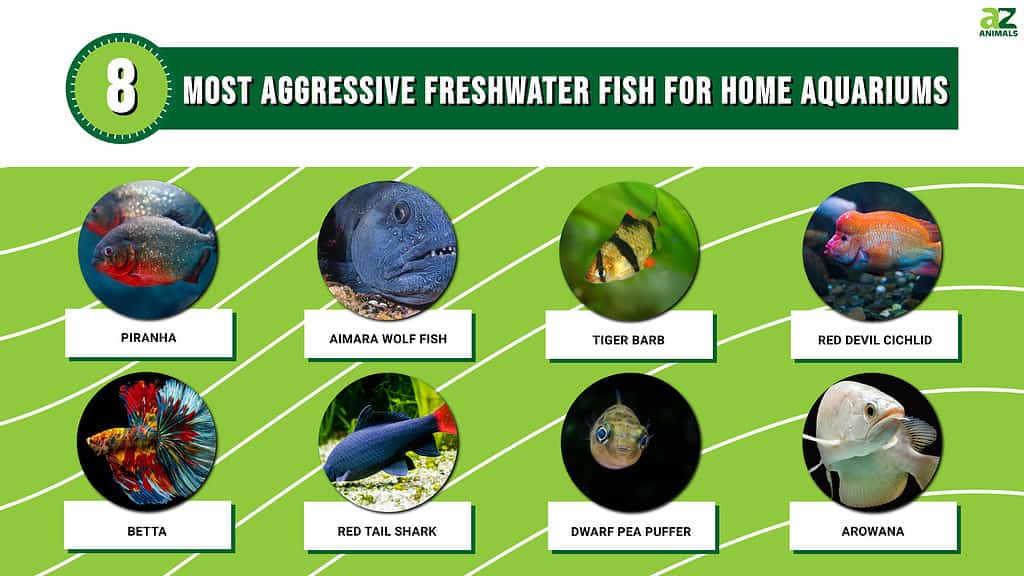
Why are Some Fish Aggressive?
First, let’s explain a bit about why some fish might be more aggressive than others. Fish can be aggressive for several reasons. One of the most common times you will see aggression is when fish guard their territory. That makes sense! They want to keep their “home” safe from other fish to have a safe place to hide and rest. Fish may also be more aggressive if they protect their eggs or fry (baby fish). This is like the “mother bear” instinct, where you don’t want to mess with a mother bear with cubs. Male fish are often aggressive during breeding because they want to impress their potential mates and fight off competition. Some aggressive fish will only be aggressive if provoked, while others seem to be bullies out looking for a fight. Here are some of the most aggressive freshwater fish you can find in home aquariums.
1) Piranha

Piranhas are omnivores and consume plants, fruits, seeds, algae, and other vegetation.
©Tatiana Belova/Shutterstock.com
Piranhas have a Hollywood reputation for being savagely aggressive fish, but are they really? Yes! Piranhas are naturally aggressive fish, often hiding together in vegetation and then ambushing their prey as a group. Large schools of piranha can take down other fish and animals much larger than themselves. As opportunistic feeders, they will eat what they can find from small fish, crustaceans, insects even birds. They also nip at larger fish tails and eat what they can snip off. Piranhas are omnivores and consume plants, fruits, seeds, algae, and other vegetation.
While you can find some tank mates that won’t become dinner, like some of the larger catfish species, many fish hobbyists prefer to keep a species-specific tank of piranha only. You can feed them live prey, but it is unnecessary. A diet of commercially prepared frozen feed cubes mixed with frozen white fish meat (thawed and served) works well. Add a variety of vegetables and fruits to round out the diet. Watching your school of piranha devours their dinner is one of the attractions to this aggressive species; they certainly are not concerned about table manners!
2) Aimara Wolf Fish
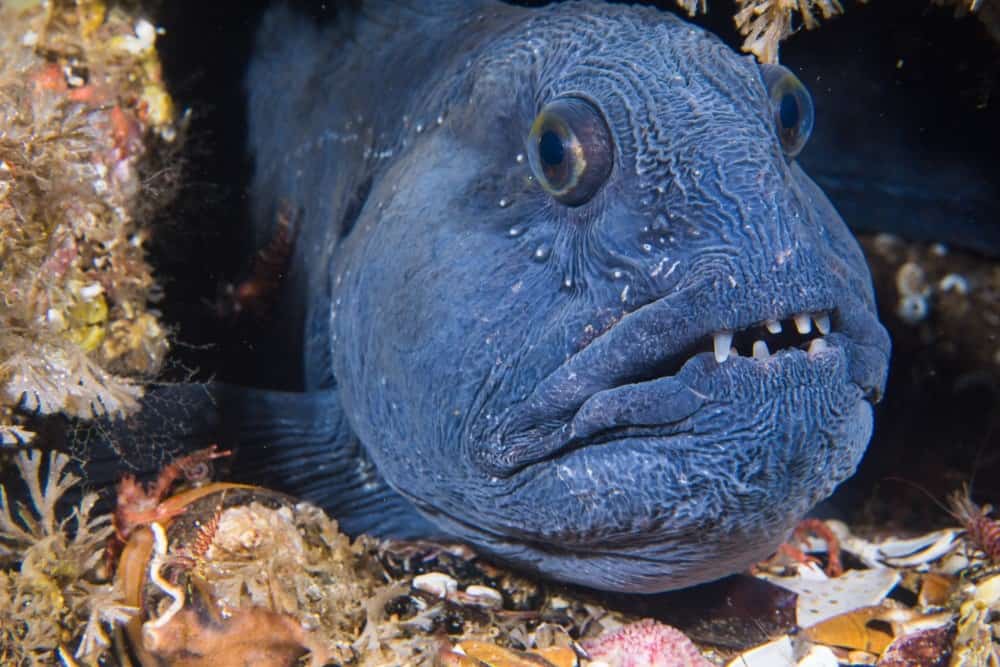
Aimara
Wolffish
is one of the most aggressive freshwater aquarium fish.
©Joern_k/Shutterstock.com
One look at the big-eyed Aimara wolf fish, and you know they mean business! Their oversized eyes are the only feature that makes them look tough. They have upturned mouths full of sharp teeth and are not afraid to use them. If you are serious about having one of the most aggressive freshwater fish in your home aquarium, you better plan big! These fish can be 2 ½ feet long and weigh 80+ pounds. They need a lot of room, so be sure you can accommodate a 300+ gallon tank. For reference, that is around 6 feet long, 4 feet wide, and 2 feet high. Aimara wolf fish, sometimes called Giant Wolf Fish, are the largest of the wolffish and are from the Amazon Basin and Orinoco Basin.
3) Tiger Barb
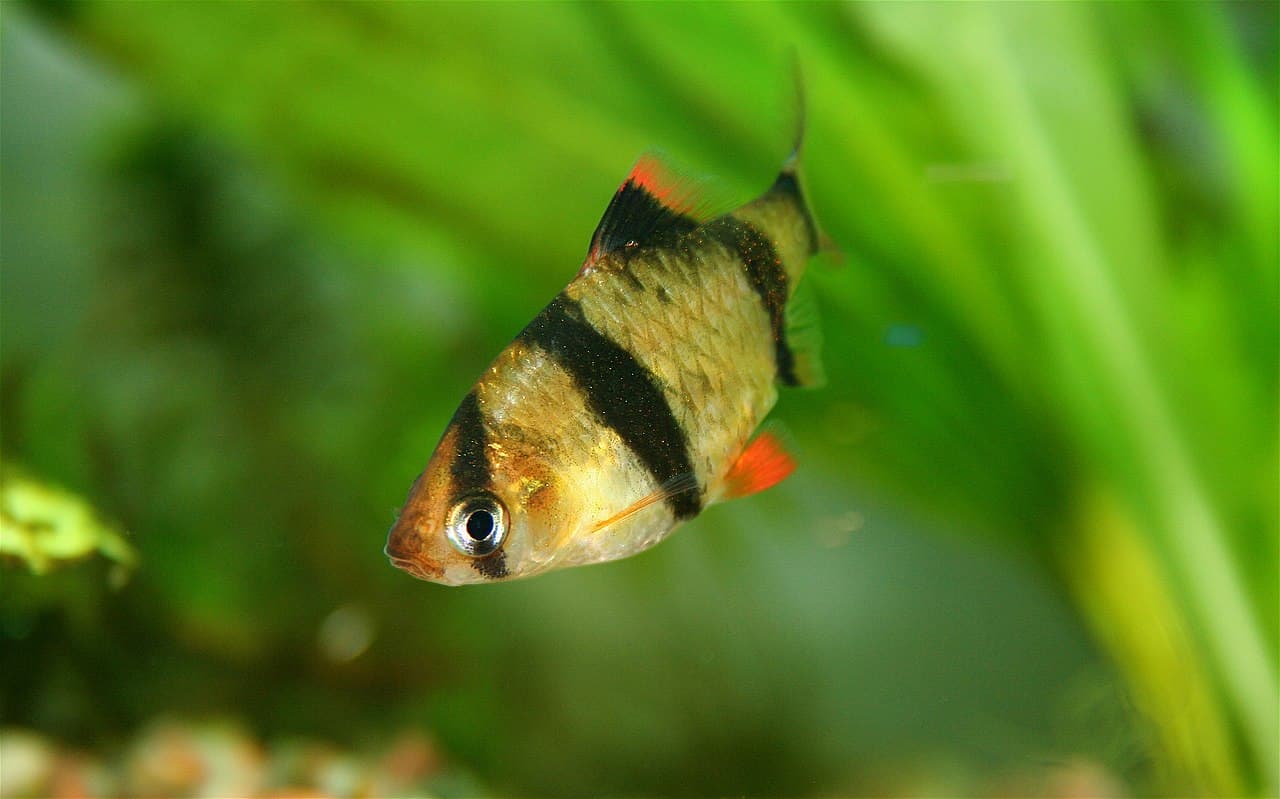
A young
tiger
barb.
©Faucon, CC BY-SA 2.5, via Wikimedia Commons – License
At the other end of the size spectrum is the small feisty tiger barb. They only get to be 3 inches long but don’t let their size fool you. If you had a couple of tiger barbs and introduced a guppy or betta into their tank, they would terrorize their new tank mate! So don’t do that! Tiger barbs are better off in single-species tanks with 6 or more so they can keep each other occupied. Tiger barbs are orangish-yellow and have four vertical black “tiger” stripes. They are originally from Borneo and Malaysia but are now found in the U.S., Australia, Columbia, and Singapore.
4) Red Devil Cichlid
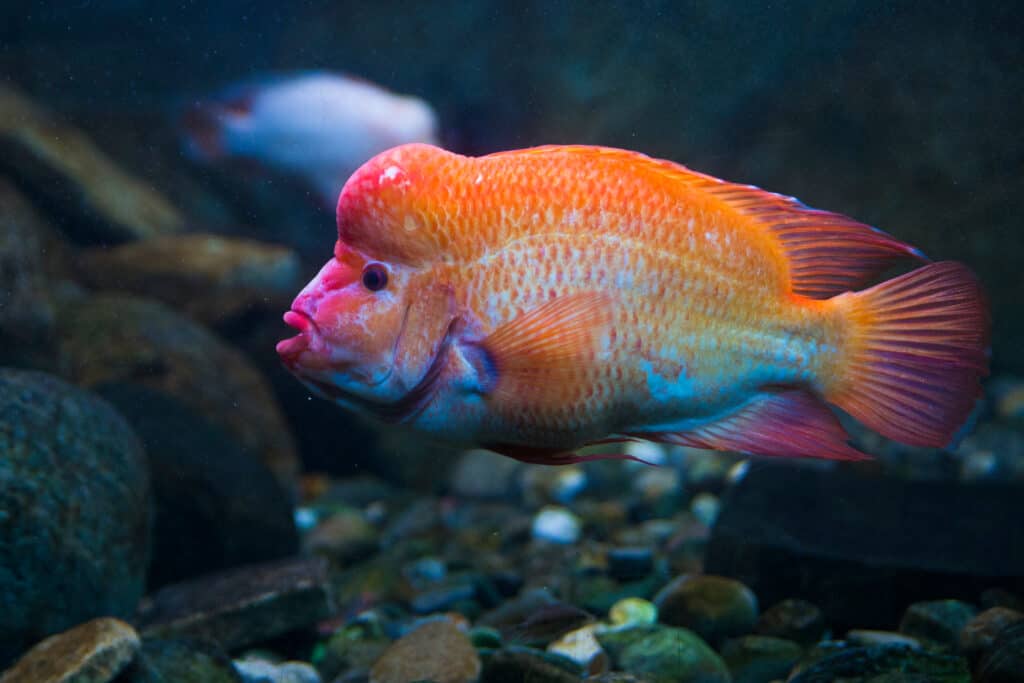
Red devil cichlids do best in a solo tank or with one partner.
©Mircea Costina/Shutterstock.com
Since their name is the red devil cichlid vs the golden angel cichlid, you know there is something behind their personality. These cichlids mean business and are known to be some of the most aggressive freshwater fish. Red devil cichlids are reddish to pinkish and have oversized lips. You might not notice the large lips because the large bulbous lump on the top of their heads (males) is the most apparent. They are very unusual-looking fish, to be sure. The average red devil is around 15 inches long, a little longer than a football. Because of their size and activity level, they need a tank of at least 55 gallons or 125 gallons if you want to have a breeding pair. Red devil cichlid really does best in a solo tank or with one partner.
Other aggressive cichlids include:
- Convict Cichlid
- Wolf Cichlid
- Jaguar Cichlid
- Clownhorn Cichlid
- Velvet Cichlid (Oscar Fish)
5) Betta
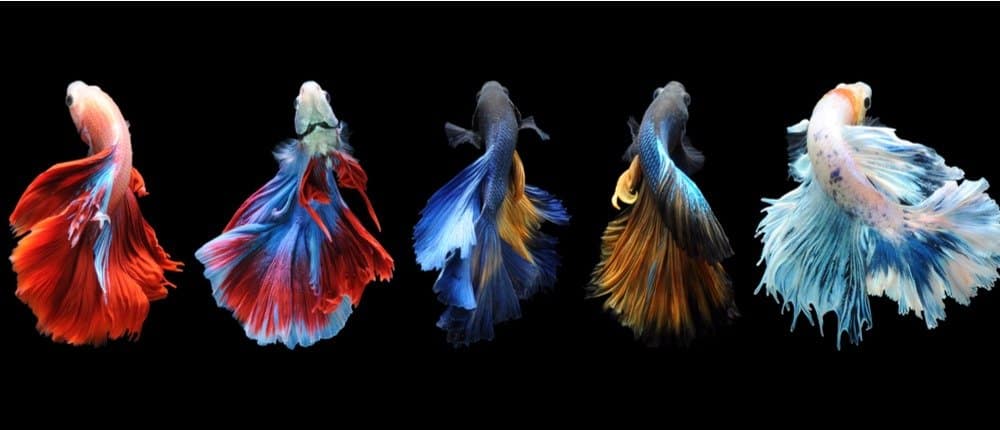
Variety of Siamese fighting fish.
©Arif Supriyadi/Shutterstock.com
Don’t be fooled by the elegant-looking betta fish. With their vibrant colors and long, flowing hair-like fins, you might think they are docile and peaceful. Maybe you already know this popular fish is one of the most aggressive; its nickname is the Siamese fighting fish. You especially do not want to put two male bettas in the same tank! In the wild (betta are originally from southeast Asia), these fish have miles and miles of paddies to swim and find their own home, so there is less need to defend their territory. If you put two male bettas in the same tank, they get territorial and usually lash out at each other. Keeping male betta by themselves or with tank mates like snails and shrimp works much better.
6) Red Tail Shark
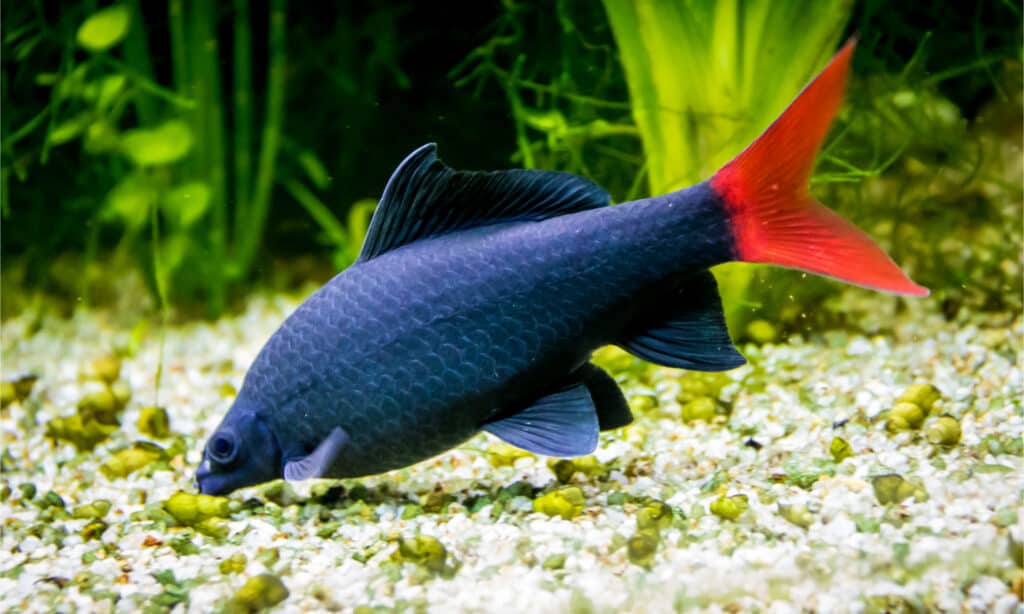
Red-tailed black shark (Epalzeorhynchos bicolor; Labeo bicolor)
©iStock.com/diegograndi
Red tail sharks are not actually sharks but a kind of carp. One of the reasons it’s called a shark is because of its shark-like personality. They are very aggressive and territorial. Not only will they fight with other redtail sharks, but they will also bully other fish if allowed. It is best to keep them in a tank on their own or provide plenty of space with a few hardier species like Barbs or Tetras. The red-tail shark is a beautiful freshwater fish with a contrasting black body and bright red tail, so you can see why fish enthusiasts like keeping them. They can grow to be about 4 ½ inches and will thrive in a tank that is 55 gallons or more.
7) Dwarf Pea Puffer
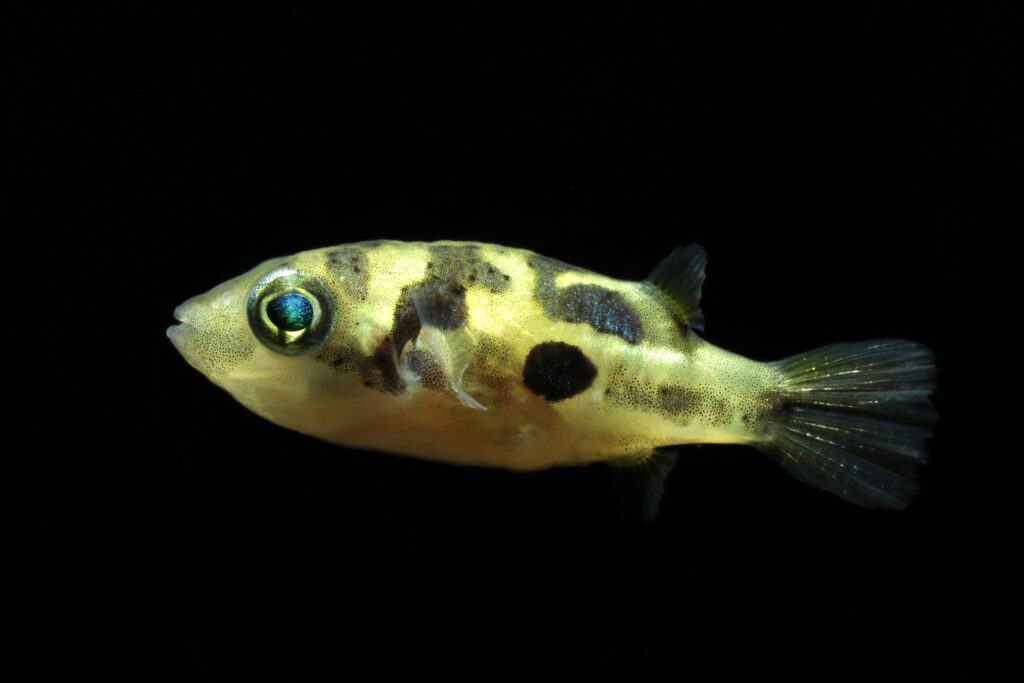
Pea puffers have yellowish bodies and dark iridescent patches along their dorsal surfaces and flanks.
©Dan Olsen/Shutterstock.com
With a name like “dwarf pea puffer,” you are probably not that intimidated, but these tiny fish have a reputation for being feisty and aggressive! Dwarf pea puffers are the smallest of pufferfish and only get to be about an inch (about the size of a gumball). When you hear “pufferfish,” you may think of the large spike-covered pufferfish found in the ocean, but there are freshwater and saltwater pufferfish. The dwarf pea puffer has a base color of tan and is covered in black splotches. Their oblong bodies dart around the tank with surprising speed. As pufferfish, they can inflate their bodies to make themselves round, a defense mechanism to scare off predators. They do well as the master of their tank with one fish per tank, or if you want tank mates, you can try kuhli loach, neon Tetras or danios, but be sure to provide a large tank with plenty of vegetation.
8) Arowana
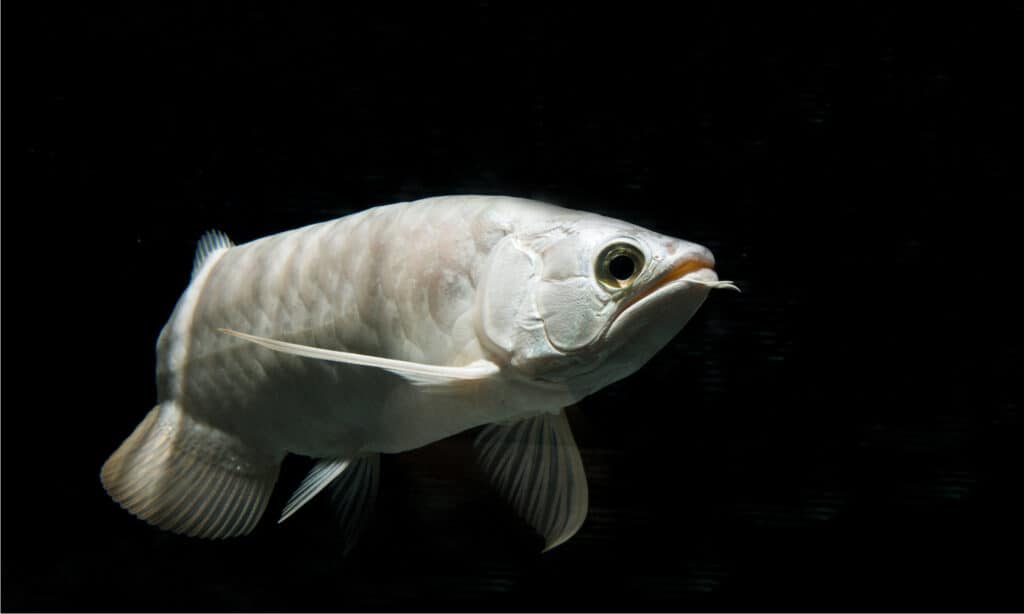
Arowana can get up to 3 feet long.
©Nantawat Chotsuwan/Shutterstock.com
At the other end of the spectrum of the tiny pea puffer is the massive Arowana. While Arowana is usually on display in public aquariums, with the right setup, you can house them in a home aquarium…a very large aquarium! Captive Arowana can get up to 3 feet long, with ones in the wild reaching lengths of more than 39 inches (100 cm). Arowana looks like they are always mad because of their upturned mouths. Two barbels stick up from their bottom lip, giving them a unique look. They have flat heads and long torpedo-like bodies. Arowana comes in various colors, including black, gold, red, and silver, with a metallic look.
If you decide to get the aggressive Arowana for your home aquarium, be sure to provide it with plenty of space. Most hobbyists recommend a tank of 250 gallons for a full-grown Arowana. It is not a good idea to have more than one Arowana in the same tank because they are so aggressive. Finding other tank mates who tolerate or can defend themselves from the bully Arowana is also difficult. A larger catfish or something like a jaguar cichlid might be able to hold its own if you want a community tank. Be prepared for the long lifespan of the Arowana because they can live from 10-20 years! Truly a fascinating freshwater fish!
Summary of the Most Aggressive Freshwater Fish for Home Aquariums
Most of these fish are so aggressive that they require a tank all to themselves!
| Rank | Fish | Special Requirement |
|---|---|---|
| 1 | Piranha | Single-species tank |
| 2 | Aimara Wolf Fish | 300+ gallon tank |
| 3 | Tiger Barb | Single-species tank |
| 4 | Red Devil Cichlid | 55 – 125 gallon, single-species tank |
| 5 | Betta | One male only |
| 6 | Red Tail Shark | 55-gallon, single-species tank |
| 7 | Dwarf Pea Puffer | Single-species tank |
| 8 | Arowana | 250-gallon, single-species tank |
4 Aggressive Freshwater Fish That Didn’t Quite Make the List
While we have listed many fish that are very aggressive for your tanks, we have a few more for you to take a look at!
- Flower Horn Cichlid
- Bucktooth Tetra
- Afer Knife
- Black Wolf Fish

©Huy Thoai/Shutterstock.com
The Flower Horn Cichlid is obviously one of the most aggressive fish for your freshwater aquarium, but they can be a great option for you as a pet owner. They have been known to respond to human interaction and seem to enjoy being playful. Although they originate in Southeast Asia, they have since been found in other parts of the world due to being distributed into the wild from captivity. This could be accidental or on purpose.
Another interesting option is the Bucktooth Tetra, which is actually better off in a larger group of Tetras rather than solo or in a small group. If there is a good bit of them around, they will not become as territorial as they will be with fewer numbers. These fish will add a great shine and shimmery pop to your fish tank, but you probably do not want to mix them with other types of fish.
The Afer Knife is a type of fish that prefers dim light and areas of your fish tank to hide because they are predators at heart. While you probably do not want to mix them with other fish in your tank, the biggest joy of owning these pets is to watch them feed on live food.
Finally, the Black Wolf Fish is another fun fish to own and watch it feed on live food. Because of its dark coloration, it will attempt to hide in dark areas and strike its prey from ambush. It is another type of fish that should be not mixed with other fish but should be fine among other fish that can move quickly and are of a decent size.
The photo featured at the top of this post is © Mr. Witoon Boonchoo/Shutterstock.com
Thank you for reading! Have some feedback for us? Contact the AZ Animals editorial team.






